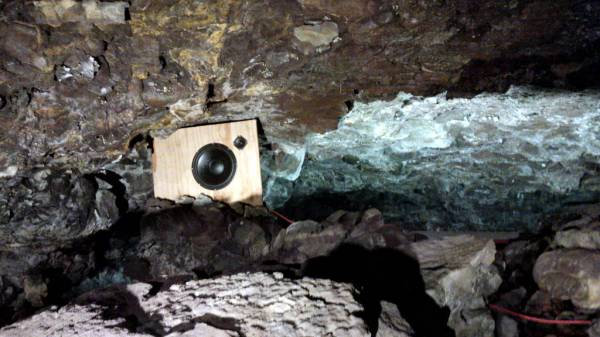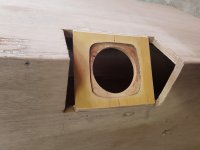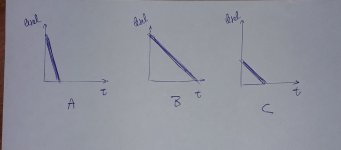Building speakers to properly fit the room corners without modifying the room gives a large delay for the early reflections, but building this way is challenging.
Do you mean like this?

I just let Pele do the building.
I have no studies to back it up, but in my experience good diffusion at the first reflection points works well. Instead of eliminating the reflections it scatters them around and doesn't sound bad. There is acoustic energy remaining, but it doesn't bother the sound bad like direct, hard reflections do.
I hope you aren't suggesting EQ can be used to deal with reflections?
No.
Building speakers to properly fit the room corners without modifying the room gives a large delay for the early reflections, but building this way is challenging. Consider treating what you have if it falls into the early category.
That room (an addition) is still in architectural review but I am thinking about design and construction detail.
My present plans are 30-35º corner wedges and I am quite o.k. with these construction challenges. It also places the drivers (wide range + woofer) closer to the side walls and therefore side wall reflections should have a smaller time delay than a placement further in the room.
I suspect it helps with the monitoring and mixing process, whether you want that kind of sound in your room is another issue
One reason I am considering this is that when I am sitting closer to my speakers (near field) I hear better detail and timbre but it yields an artificially wide sound field and is a suboptimal position for bass. So having less early reflections might be close to near field but with a more reasonable soundstage width.
As my speakers have a single crossover point at around 200Hz it would be likely very easy to compensate for bass gain via DSP.
Your way may be the epitome of a diffuse environment.. No, I was talking of a clean entry with the intention of reducing reflections. Attachment is a rear view of a sub 700Hz radial that sits flush into a room corner. (The pic has been rotated 90deg, sorry)Do you mean like this?
Attachments
Are you seeing this as the problem or something you want?side wall reflections should have a smaller time delay than a placement further in the room.
One benefit of the flush mount will be the smooth directivity index into the baffle step region by eliminating it as an issue. (Normally you'd try for pseudo-random distribution of modes through speaker placement.) The reflections can cause comb filtering at frequencies where it's hard to prevent, thus a large acoustic mirror is a plus.
If your speakers are good, you don't need acoustic treatment. Multiple subs and eq work just fine.
If your speakers are bad, no amount of acoustic treatment can make them sound great. It can improve it though.
I'm looking at digital processing these days, and I have a lot of doubts and ignorance. PE:
If at a given frequency the signal has shape as in A, in the time domain;
If it produces in the room the shape in B ;
After equalization will it take shape like in C?
Is it the area of the triangle that matters?
Does the time window of the measurement have to correspond in some way to the integrative features of the auditory system?
Or is it simply a distortion in the time domain that we can not equalize correctly by controlling the signal level?
Attachments
This should help Why Can't I Fix All my Acoustic Problems with EQ?I'm looking at digital processing these days, and I have a lot of doubts and ignorance.
Reflections that a monitor produces are determined by the physical size of the speakers, the bandwidth and the shape of the baffle. No EQ can change anything about that.I'm looking at digital processing these days, and I have a lot of doubts and ignorance. PE:
If at a given frequency the signal has shape as in A, in the time domain;
If it produces in the room the shape in B ;
After equalization will it take shape like in C?
Is it the area of the triangle that matters?
Does the time window of the measurement have to correspond in some way to the integrative features of the auditory system?
Or is it simply a distortion in the time domain that we can not equalize correctly by controlling the signal level?
And if the reflections produced are to frequency dependant, no amount of acoustic treatment can make the speaker sound great.
But EQ can help in making the lower frequencies more even in one listening area. Add more subs and the frequency response can get more even in a larger listening area.
Don't worry to much about phase, humans are mostly deaf to phase differences. Only in extreme cases its audible.
I listen to my dipoles nearfield, in fact if I move almost between them the image just keeps improving, it could be that I like the late reflections from the front wallOne reason I am considering this is that when I am sitting closer to my speakers (near field) I hear better detail and timbre but it yields an artificially wide sound field and is a suboptimal position for bass. So having less early reflections might be close to near field but with a more reasonable soundstage width.
As my speakers have a single crossover point at around 200Hz it would be likely very easy to compensate for bass gain via DSP.
I'm not sure what you mean by an artificially wide sound field? Do you get a hole? Also I don't see why nearfield should be suboptimal for bass?
I will speak to two places that you do not have it correct. This is like a True/False question on the final exam.
I don't see how this attitude helps.
True / False; First reflections are always bad? If there is one exception the answer is false.
How is this relevant to the discussion? No one in this thread said that it's one or the other.
Early reflections are not always bad. But in the context of small rooms for stereo listening, they *usually* are.
The article you slapped up earlier explains that they usually control first reflections in the rooms they treat. The thrust of that article wasn't that first reflections must always be allowed to exist, but that attention needs to be paid to spectral content in your method of controlling them. In most cases they do control early reflections, but they pay close attention to the results in terms of spectral make-up in the hearing zone.
You can control how much of the reflection stays in the room in each band by using different thicknesses of absorption, or by using a diffuser instead of an absorber. That's the gist of my response, which you claim fails "acoustics 101". Sometimes we want to keep that energy, sometimes we don't, sometimes we just want to keep some of it. The purpose of controlling first reflections is to reduce any confusion your brain has about where the signal is coming from, and we should do that in a way that's conscious of how much reflected sound we want to keep in the room to maintain a spectral signature that resembles the source.
First, you have forgotten who the client is. You seem intent to sell him a large live performance auditorium with adjustable sidewall diffusers. What your client has is a small 3000 cubic foot playback/listening room.
If we were talking about a live performance auditorium, we would *embrace* early reflections for reinforcement. So, no, I'm not confused about the space we're dealing with here.
You want the listener to hear the performer in the space the performance took place. The goal is to put the listener "in the room" with the performer because that is how you create an immersive experience.
If both the listener and the performer are in the same room, then feeling "in the room" is automatic and we can further enhance the experience with direct reflections. These add to the experience because they reinforce the sound, which is especially important for an acoustic performance, and because they further tie the listener and performer together through the boundaries of the space.
If the listener is hearing a recording in another place, and this can include an imaginary space that's invented through effects, we want to decouple the listener from the room they're in to some extent to allow the recording to transport the listener to the intended destination. If the source is a jazz 3-piece, then it makes sense to create the illusion that the performers are in your own room with you. But if you're listening to an orchestra, the better illusion is that the listener is in the auditorium, not that the orchestra is crammed into your basement.
Secondly, early or first reflections are not necessarily bad or good, they are just the nature of the beast. You can manage and control them to your advantage. You do not need to put a stake in their heart to kill them.
Certainly. And no one in this thread said anything that disagrees with that.
One school of thought is to use Controlled Directivity speakers to aim or direct the speaker beamwidth where you want it to go. This approach limits unintended frequencies from just bouncing, without purpose, around the room. The right ear will receive direct sound from the right speaker. The left ear is in the sound shadow of the head and torso and will hear sound from the right speaker as a first reflection from the near wall. Vice versa for the left speaker, direct sound at the left ear, right ear is in the head torso shadow and the first reflections arrive at the right ear. Our brains are amazingly effective at extracting perceived soundstage information from this setup.
Do you understand that the purpose of controlling early reflections is to make direct sound from the speakers the controlling source in the hearing zone?
The constant "school of thought" at acoustics firms is always to use passive control when possible. This means we design the room to behave the way we want. We only rely on fancy electronics when it's absolutely necessary. Passive controls are far more robust than active. This should be obvious.
I am a consultant of more than a few years. In this context my thing is more about noise and vibration. One School of Medicine research lab constructed of Ductile Moment Seismic Resistant construction shook so bad when a delivery truck drove down the street the field of view on the Scanning Electron Microscopes shook so bad that the building turned into facility offices and junk storage. A new replacement building of cast in place concrete (same thin brick veneer) was built next door in the parking lot.
I've been on the design team for medical buildings with this type of equipment. We control these problems in the design phase so that they don't have to be sorted out later at 10 times the cost.
Are you seeing this as the problem or something you want?
One benefit of the flush mount will be the smooth directivity index into the baffle step region by eliminating it as an issue. (Normally you'd try for pseudo-random distribution of modes through speaker placement.) The reflections can cause comb filtering at frequencies where it's hard to prevent, thus a large acoustic mirror is a plus.
I see reflections which are too early and too little attenuated a problem that my brain is not lumping direct sound with the room (just like having a conversation leaning against a wall versus away from it).
I listen to my dipoles nearfield, in fact if I move almost between them the image just keeps improving, it could be that I like the late reflections from the front wall
I'm not sure what you mean by an artificially wide sound field? Do you get a hole? Also I don't see why nearfield should be suboptimal for bass?
I mean a sound field that is much wider than one can experience with live music.
I am not saying near field per se is suboptimal for bass, just in my room at that position are the wrong nodes!
The stuff of early reflections is what builds the imaginary sound stage in our small listening rooms. I prefer the description “illusion” to imaginary.
More particularly, direct sound to one ear and early reflection to the other ear in the sound shadow of the head and torso of the listener creates the perception of depth. Additional later reflections provide the perception of space.
This is where the exception may occasionally become the rule. Sometimes and places with magic microphones and a touch of convolution some of sense live performance venue may be added to the mix.
Playing with this stuff I am still working on a preference. If I use the 100 X 100 degree beamwidth speaker approach the playback room has a palpable sense of space however the illusion of sound stage is a bit lacking. If I use the 90 X 50 degree beamwidth the sense of space is not so palpable however the illusion of sound stage is much more clearly defined. The mechanics of this is well toed in speakers that cross well in front of the listening position.
At home try this out. Toe in your speakers to varying degrees. Report back the sound stage effect. The right ear has direct sound. The left ear has first reflections of the right speaker. The left ear has direct sound. The right ear has first reflections of the left speaker.
Thanks DT
More particularly, direct sound to one ear and early reflection to the other ear in the sound shadow of the head and torso of the listener creates the perception of depth. Additional later reflections provide the perception of space.
This is where the exception may occasionally become the rule. Sometimes and places with magic microphones and a touch of convolution some of sense live performance venue may be added to the mix.
Playing with this stuff I am still working on a preference. If I use the 100 X 100 degree beamwidth speaker approach the playback room has a palpable sense of space however the illusion of sound stage is a bit lacking. If I use the 90 X 50 degree beamwidth the sense of space is not so palpable however the illusion of sound stage is much more clearly defined. The mechanics of this is well toed in speakers that cross well in front of the listening position.
At home try this out. Toe in your speakers to varying degrees. Report back the sound stage effect. The right ear has direct sound. The left ear has first reflections of the right speaker. The left ear has direct sound. The right ear has first reflections of the left speaker.
Thanks DT
Trying to understand, I think these two statements contradict.
The stuff of early reflections is what builds the imaginary sound stage
Are you trying to say that if I eliminate early reflections I have no sound stage? because I would disagree..If I use the 90 X 50 degree beamwidth the sense of space is not so palpable however the illusion of sound stage is much more clearly defined.
It's not just speakerplacement, the speakers themselves and the room that determines the Soundstage.
It's the microphone technology used as well.
Image Assistant | SCHOEPS Mikrofone
So what are you listening to?
It's the microphone technology used as well.
Image Assistant | SCHOEPS Mikrofone
So what are you listening to?
Trying to understand, I think these two statements contradict.
Are you trying to say that if I eliminate early reflections I have no sound stage? because I would disagree..
Not contradictory at all.
The more controlled and aimed the beamwidth the more defined the the illusion of sound stage can be. You may not care for this configuration. The less focused and aimed the beamwidth the sound stage tends to be less well defined and the sense of space is increased. you may not care for this setup eitherNot saying that first reflections will ever go away in your small listening room or that the sound stage will completely disappear. I do prefer either or both of these to headphones with the same recording in the same chair in the same room.
Do try adjusting the speaker toe-in and tell us what you think about the variable effect on sound stage.
Thanks DT
- Status
- This old topic is closed. If you want to reopen this topic, contact a moderator using the "Report Post" button.
- Home
- General Interest
- Room Acoustics & Mods
- early reflection of sidewalls: absorption or not?

